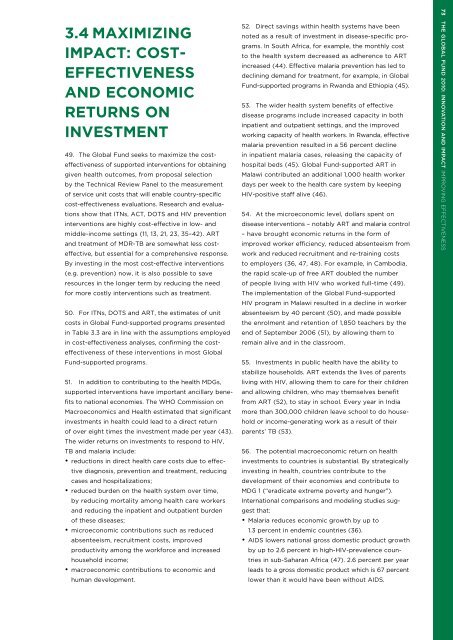Global Fund: Progress Report 2010 - unaids
Global Fund: Progress Report 2010 - unaids
Global Fund: Progress Report 2010 - unaids
Create successful ePaper yourself
Turn your PDF publications into a flip-book with our unique Google optimized e-Paper software.
3.4 Maximizing<br />
impact: costeffectiveness<br />
and economic<br />
returns on<br />
investment<br />
49. The <strong>Global</strong> <strong>Fund</strong> seeks to maximize the costeffectiveness<br />
of supported interventions for obtaining<br />
given health outcomes, from proposal selection<br />
by the Technical Review Panel to the measurement<br />
of service unit costs that will enable country-specific<br />
cost-effectiveness evaluations. Research and evaluations<br />
show that ITNs, ACT, DOTS and HIV prevention<br />
interventions are highly cost-effective in low- and<br />
middle-income settings (11, 13, 21, 23, 35–42). ART<br />
and treatment of MDR-TB are somewhat less costeffective,<br />
but essential for a comprehensive response.<br />
By investing in the most cost-effective interventions<br />
(e.g. prevention) now, it is also possible to save<br />
resources in the longer term by reducing the need<br />
for more costly interventions such as treatment.<br />
50. For ITNs, DOTS and ART, the estimates of unit<br />
costs in <strong>Global</strong> <strong>Fund</strong>-supported programs presented<br />
in Table 3.3 are in line with the assumptions employed<br />
in cost-effectiveness analyses, confirming the costeffectiveness<br />
of these interventions in most <strong>Global</strong><br />
<strong>Fund</strong>-supported programs.<br />
51. In addition to contributing to the health MDGs,<br />
supported interventions have important ancillary benefits<br />
to national economies. The WHO Commission on<br />
Macroeconomics and Health estimated that significant<br />
investments in health could lead to a direct return<br />
of over eight times the investment made per year (43).<br />
The wider returns on investments to respond to HIV,<br />
TB and malaria include:<br />
• reductions in direct health care costs due to effective<br />
diagnosis, prevention and treatment, reducing<br />
cases and hospitalizations;<br />
• reduced burden on the health system over time,<br />
by reducing mortality among health care workers<br />
and reducing the inpatient and outpatient burden<br />
of these diseases;<br />
• microeconomic contributions such as reduced<br />
absen teeism, recruitment costs, improved<br />
productivity among the workforce and increased<br />
household income;<br />
• macroeconomic contributions to economic and<br />
human development.<br />
52. Direct savings within health systems have been<br />
noted as a result of investment in disease-specific programs.<br />
In South Africa, for example, the monthly cost<br />
to the health system decreased as adherence to ART<br />
increased (44). Effective malaria prevention has led to<br />
declining demand for treatment, for example, in <strong>Global</strong><br />
<strong>Fund</strong>-supported programs in Rwanda and Ethiopia (45).<br />
53. The wider health system benefits of effective<br />
disease programs include increased capacity in both<br />
inpatient and outpatient settings, and the improved<br />
working capacity of health workers. In Rwanda, effective<br />
malaria prevention resulted in a 56 percent decline<br />
in inpatient malaria cases, releasing the capacity of<br />
hospital beds (45). <strong>Global</strong> <strong>Fund</strong>-supported ART in<br />
Malawi contributed an additional 1,000 health worker<br />
days per week to the health care system by keeping<br />
HIV-positive staff alive (46).<br />
54. At the microeconomic level, dollars spent on<br />
disease interventions – notably ART and malaria control<br />
– have brought economic returns in the form of<br />
improved worker efficiency, reduced absenteeism from<br />
work and reduced recruitment and re-training costs<br />
to employers (36, 47, 48). For example, in Cambodia,<br />
the rapid scale-up of free ART doubled the number<br />
of people living with HIV who worked full-time (49).<br />
The implementation of the <strong>Global</strong> <strong>Fund</strong>-supported<br />
HIV program in Malawi resulted in a decline in worker<br />
absenteeism by 40 percent (50), and made possible<br />
the enrolment and retention of 1,850 teachers by the<br />
end of September 2006 (51), by allowing them to<br />
remain alive and in the classroom.<br />
55. Investments in public health have the ability to<br />
stabilize households. ART extends the lives of parents<br />
living with HIV, allowing them to care for their children<br />
and allowing children, who may themselves benefit<br />
from ART (52), to stay in school. Every year in India<br />
more than 300,000 children leave school to do household<br />
or income-generating work as a result of their<br />
parents’ TB (53).<br />
56. The potential macroeconomic return on health<br />
investments to countries is substantial. By strategically<br />
investing in health, countries contribute to the<br />
development of their economies and contribute to<br />
MDG 1 (“eradicate extreme poverty and hunger”).<br />
International comparisons and modeling studies suggest<br />
that:<br />
• Malaria reduces economic growth by up to<br />
1.3 percent in endemic countries (36).<br />
• AIDS lowers national gross domestic product growth<br />
by up to 2.6 percent in high-HIV-prevalence countries<br />
in sub-Saharan Africa (47). 2.6 percent per year<br />
leads to a gross domestic product which is 67 percent<br />
lower than it would have been without AIDS.<br />
73 THE GLOBAL FUND <strong>2010</strong>: INNOVATION AND IMPACT imprOviNG EFFectiveNess

















